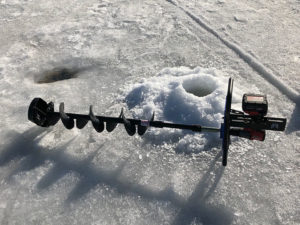By Steve Weisman
As I sat ice fishing in the protection of my Fish Trap Pro late last winter, I thought back to the changes that have taken place over the past 65 years that I have ice fished. So many changes, so many upgrades…but ones that make the sport of ice fishing that much more pleasurable. One area that has really changed is the way we approach cutting an ice hole.
Those of you who are my age (73) will probably remember these different stages, while you younger anglers will probably just shake your head and say, “You really did that?” Certainly, it’s not the only one out there, and each of us “grumpy old men” has our own version of the cutting ice journey to today.
The axe and spud bar
Back in the 50s, my dad only used what we had available: an axe and a spud bar. The axe would only work when the ice was not very thick-maybe less than a foot. We had to start with a pretty big hole to be able to get the head of the axe down to the bottom of the ice. The handle usually took a beating, and we did accidentally break a handle or two with a missed swing of the axe.
As for the spud bar, it could be used making an ice hole in thicker ice, because you just pounded it up and down chipping away at the ice, kind of like a manual hand jack hammer. From experience, my dad taught me to put a rope through the eyelet at the top of the spud bar and then wrap it around my hand – lots of spud bars ended up at the bottom of the lake, when it slipped out of the hand and went down the hole.
You also had to start with a large opening at the top, because by the time you reached the bottom of the hole, the hole was about half the size as when you started at the top. No matter how hard I tried, it just kept getting smaller. And, wow, was it slow going. One spud at a time. Not a lot of hole hopping in those days. The spud bar is still used today, but it’s now use mostly at late ice to re-open recently re-frozen old holes.
Early hand augers
Then in the late 60s, I got what was called a spoon auger. The cutting part was in the shape of a big spoon-I think mine was a six incher or so. It was on about a four foot straight shaft with a bump out on the shaft to put your hand to turn the spoon with a handle at the top, where you would put your other hand. You’d find your spot, put the spoon on the ice and begin turning the spoon. As long as the spoon was sharp, you were fine. Once it dulled or became chipped on the cutting edge, it’d just kind of spin on top and barely go down.
I scrapped that one for the famous StrikeMaster Mora blue hand auger. It was a Godsend to use and with its stainless steel blades, it cut much better than anything I had used before. Even today, the blue Mora is still used. It’d drill as deep as you wanted, but it was definitely “arm strong” drilling. You didn’t do a lot of hole hopping with one of those. Then in the early 90s, StrikeMaster came up with a true cutting edge hand auger: the StrikeMaster Lazer hand auger. Yes, the Lazer was the next step in cutting. I purchased a six-inch auger and found that it was awesome for cutting holes up to 12 inches of ice and for re-opening old holes. I still have mine and used it on early ice until a year ago.
There was still an issue, however. Thick ice. I simply didn’t like, didn’t have the endurance to drill lots of holes in two feet of ice.
Gas powered augers
Going back to the late 60s, that’s when my dad purchased a Jiffy gas powered auger, one of the first anybody had seen in northcentral South Dakota. Boy could it cut ice, and boy was it heavy! It was really beast to haul around, but it was a cutting fool. Not long after, my father-in-law got one just like it.
I used it for several years, but I was always on the outlook for a lighter version of a power auger, and I went to a StrikeMaster 4-stroke power auger. It was lighter, but it was still around 25 pounds. Most of the gas powered augers run anywhere from the 20s to 30+ pounds. Plus you have to use gas. I used different versions of the StrikeMaster augers for probably 25 years. As a matter of fact, my StrikeMaster power auger is still stored in my garage.
Then a few years ago, manufacturers began to come out with battery powered (electric) augers. They were still pretty heavy. I tried them, but at that time I felt they didn’t hold their charge well enough for me to consider doing a lot of hole hopping like I could with my gas powered auger.
The electric auger revolution
In the last 3-4 years, that has changed. We have now hit the new era. Battery operated augers that weigh less, cut faster and hold their charge much better. Plus, having a spare battery gives you a lot of hole hopping ability. Plus, it’s quiet and instant power. Some choices include true battery operated augers that look like the traditional gas powered auger. These all-in-one electric augers now are in the 20-24 pound range. They are quiet, fast cutting and efficient. With a charged spare battery, there’s plenty of energy to do a lot of hole hopping.
Up until a year ago, I stuck with my Lazer hand auger and my StrikeMaster power auger. Finally, I grew tired of the gas, the need to use the choke, then let it warm up before using and lugging it around on the ice. Now in my 70s, I simply don’t have the strength and stamina that I did even in my 60s!
So, a year ago, I did my research and ultimately made my decision. My first option was the all-in-one electric/battery unit with the two most popular being the Ion Lithium or the StrikeMaster 40-V. Next came the Vexilar K Drill auger that attaches to a battery operated 18-volt drill. The final option was coming up with my own hybrid.
My choice: a hybrid
After a lot of research and talking with other ice anglers and one of my local baitshops, I came up with my choice. My grandson Hunter Wheatley worked at Kabele’s at that time, and I trusted his working with his customers and taking into consideration their “want list” and reviews of what they liked and disliked.
I eventually did go with a hybrid. Here is the unit and how it works:
- an eight-inch StrikeMaster Lite-Flite Lazer auger (5.2 pounds). I chose this because I loved the StrikeMaster Lazer hand auger that I currently have. The auger came with a blade cover that is definitely a necessity. It protects the blades so they don’t get dull.
- a Clam drill plate kit (conversion kit) and power drive (5 pounds). This plate provides a stable platform that you can grab with both hands so it’s easily controlled.
- a Milwaukee M 18 Fuel 18-volt drill with heavy duty lithium battery (1 pound).
- The drill is securely attached to a bar above the drill plate and down through the plate with a power drive accessory that goes into the opening on the drill and then attaches to the auger to reduce the torque on the drill and help stabilize the entire unit.
- It’s light weight at just under 12 pounds, yet it is a cutting fool. It is so quick with an immediate response when you pull the trigger.
- The power is incredible, and there is no wobble and no hangup at the bottom of the ice hole. It just powers right on through. My guess is that it cuts an inch per second.
- I purchased a Milwaukee M 18 combo that included two heavy duty lithium batteries and a charger.
- Total cost was around $500, which is about what an all-in-one electric would cost.
What a journey this 65-year ice cutting journey has been. I’m sure there will be more advancements made in the future, but right now, I feel good about my choice for my auger. It really does come down to what you, yourself, are interested in. This has just been my journey!

(photo by Steve Weisman) The author’s “hybrid” battery powered ice fishing auger beside a newly drilled hole late last winter.















